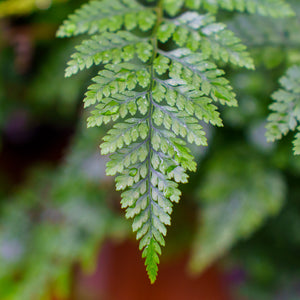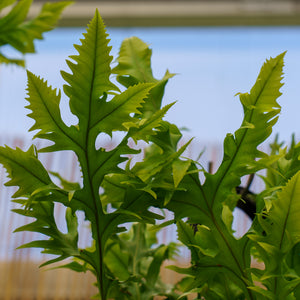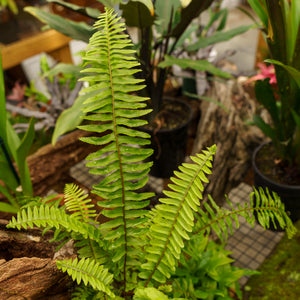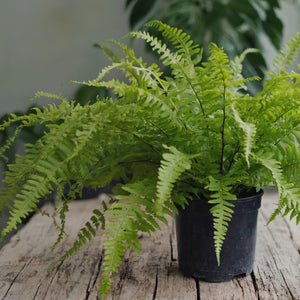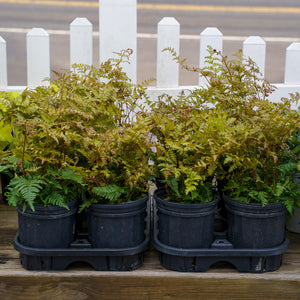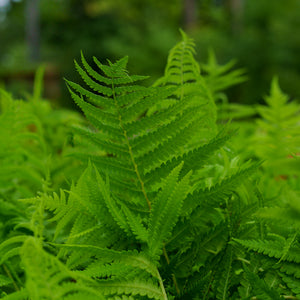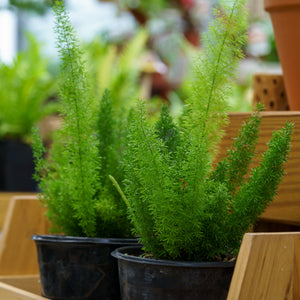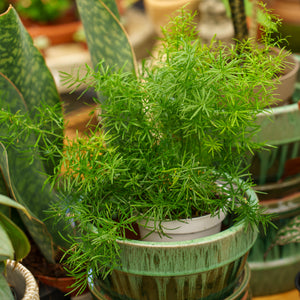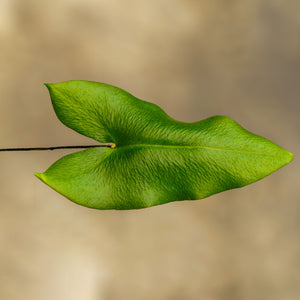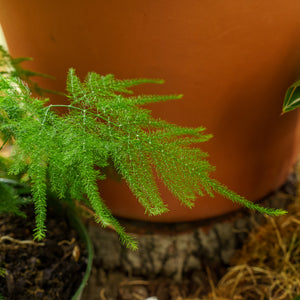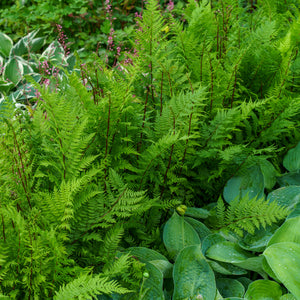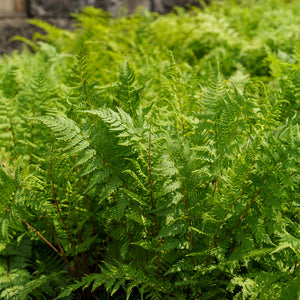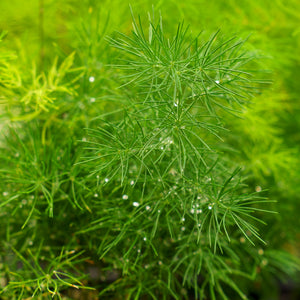The Fern Guide
Ferns, with their lush green fronds and graceful, feathery appearance, bring a touch of timeless elegance to any garden landscape. Known for their ability to thrive in shady, moist environments, ferns are perfect for adding texture and a sense of tranquility to borders, beds, and woodland gardens. Their delicate, arching fronds and low-maintenance nature make them a favorite among gardeners of all levels. Whether you're seeking to create a lush, shaded retreat or add some greenery to a damp corner of your garden, ferns offer a versatile solution. With minimal maintenance requirements and adaptability to different soil types and light conditions, ferns are a hassle-free addition to any garden. Explore our Fern Guide to learn more about cultivating and caring for these enchanting perennials, and discover how to incorporate them into your garden for lasting beauty and enjoyment.
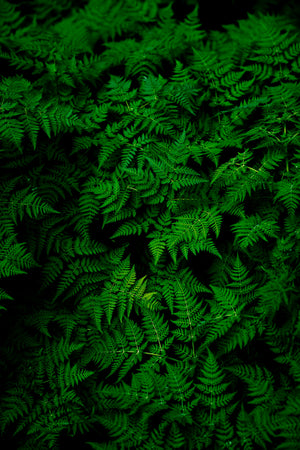
About
Ferns belong to a diverse group of plants known for their lush, green fronds and unique reproductive methods through spores rather than seeds. These ancient plants have a rich evolutionary history dating back millions of years and can be found thriving in shaded, moist environments worldwide. Ferns are prized for their ornamental value, adding a touch of graceful foliage and a sense of tranquility to gardens, woodland areas, and indoor spaces alike.
Characterized by their delicate, feathery leaves called fronds, ferns vary widely in size and shape, from small ground covers to towering tree ferns. Their ability to thrive in low-light conditions and their preference for well-drained, humus-rich soils make them versatile and adaptable to various garden settings. Ferns play a crucial role in ecosystems by providing habitat and food for various wildlife, contributing to biodiversity conservation.
In addition to their aesthetic appeal, ferns have cultural significance and have been used in traditional medicine and craftsmanship across different cultures. Whether used as accent plants in shaded borders, as ground covers, or as focal points in landscaped areas, ferns offer a timeless beauty that enriches any garden environment.
By incorporating ferns into your garden, you not only enhance its natural beauty but also create a sustainable ecosystem that supports biodiversity and provides a serene green retreat for relaxation and enjoyment.
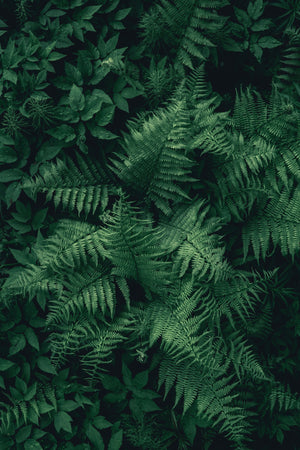
Planting
Ferns thrive in environments with specific planting conditions that support their unique growth habits. Here are essential guidelines for planting and caring for ferns:
- Soil: Ferns prefer well-drained, humus-rich soil that retains moisture without becoming waterlogged. They thrive in soil with a slightly acidic to neutral pH (around 5.5 to 7.0). Incorporate organic matter such as compost or leaf mold when preparing the planting site to improve soil structure and fertility.
- Sunlight: Most ferns prefer shade to partial shade, making them ideal for woodland gardens or shaded areas. Avoid planting ferns in direct sunlight, especially during the hottest parts of the day, as this can cause their delicate fronds to scorch or wilt.
- Watering: Adequate moisture is crucial for ferns, especially during their early growth stages. Water ferns regularly to keep the soil consistently moist but not waterlogged. Aim to water deeply at the base of the plant to encourage deep root growth. Mulching around ferns helps retain moisture and regulate soil temperature.
- Spacing: Plant ferns with enough space between them to allow for their spreading growth habit. Space them according to their mature size, typically ranging from 12 inches to several feet apart, depending on the species.
- Planting Time: Spring and early fall are ideal times to plant ferns. Planting in spring allows them to establish before the heat of summer, while fall planting takes advantage of cooler temperatures and increased rainfall for root development.
- Maintenance: Remove any dead or yellowing fronds periodically to promote new growth and maintain a tidy appearance. Trim back dead foliage in late winter or early spring to prepare for new growth.
By following these planting and care instructions, you can create a thriving environment for your ferns, enhancing the beauty and tranquility of your garden or landscape. Ferns' lush foliage and adaptability make them an excellent choice for adding texture and greenery to shaded areas or woodland settings.
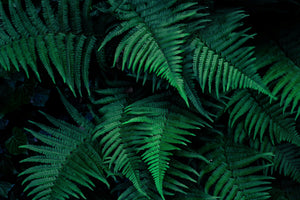
Care
Ferns require specific care to ensure their optimal growth and health, maintaining their lush foliage and graceful appearance. Here are some general guidelines for caring for ferns:
- Watering: Ferns thrive in consistently moist soil. Water them regularly to keep the soil evenly moist, especially during dry periods. Avoid overwatering, which can lead to root rot. Water at the base of the plant to prevent fungal diseases and aim to maintain a humidity level that mimics their natural habitat.
- Humidity: Ferns prefer high humidity levels. To increase humidity, mist the fronds regularly, especially in dry indoor environments or during hot weather. Placing a humidity tray filled with water and pebbles beneath the fern's pot can also help.
- Light: Most ferns prefer indirect or filtered light, such as that found under the canopy of trees or in lightly shaded areas. Avoid direct sunlight, as it can scorch their delicate fronds. However, some fern varieties can tolerate more light and may benefit from morning sun or dappled sunlight.
- Soil: Use well-draining, loose, and rich soil for ferns. A mixture of peat moss, compost, and perlite or sand works well. Ensure good drainage to prevent waterlogging, which can lead to root rot.
- Fertilizing: Feed ferns with a balanced, water-soluble fertilizer diluted to half strength every two to four weeks during the growing season (spring through early fall). Reduce feeding frequency in winter when ferns are dormant.
- Pruning: Remove any yellowing or dead fronds regularly to promote new growth and maintain a tidy appearance. Trim back old or damaged fronds close to the base using clean, sharp scissors or pruning shears.
- Mulching: Apply a layer of organic mulch, such as leaf mold or compost, around the base of ferns to retain moisture, suppress weed growth, and provide nutrients as it breaks down. Keep the mulch a few inches away from the fern's crown to prevent fungal diseases.
- Winter Care: In colder climates, protect outdoor ferns from frost by covering them with a layer of mulch or bringing potted ferns indoors. Reduce watering during winter months but ensure the soil remains slightly moist.
- Pests and Diseases: Ferns are generally resistant to pests and diseases when grown in optimal conditions. However, watch for signs of aphids, scale, or fungal diseases like leaf spot. Treat any issues promptly with insecticidal soap or a fungicide suitable for ferns.
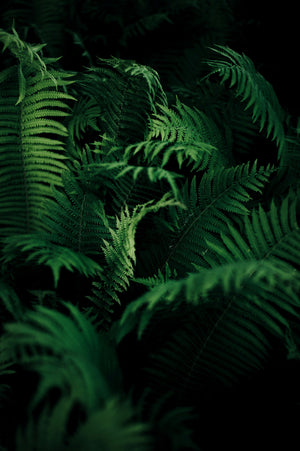
How To Use
Ferns offer versatile options for enhancing your landscape with their graceful foliage and lush greenery. Here are several ways to incorporate ferns into your garden or indoor spaces:
- Shade Gardens: Ferns thrive in shaded areas, making them perfect for creating serene and lush shade gardens. Plant them under trees or in areas where direct sunlight is limited to add texture and depth to your garden.
- Woodland Gardens: Ferns naturally occur in woodland settings and complement native plants beautifully. Plant them alongside other shade-loving plants like hostas and astilbes to create a woodland-inspired garden that thrives in dappled sunlight.
- Borders and Edging: Use ferns to create soft borders or edging along pathways or garden beds. Their feathery fronds provide a gentle contrast to flowering plants and can help define garden spaces.
- Container Gardening: Ferns are well-suited for container gardening, making them ideal for patios, balconies, or shaded corners of your yard. Plant them in pots with good drainage and place them in shaded areas to enjoy their foliage up close.
- Indoor Décor: Ferns are popular choices for indoor plants due to their ability to thrive in low-light conditions and their air-purifying qualities. Place ferns in decorative pots and use them as accents in living rooms, offices, or bathrooms to bring a touch of nature indoors.
- Ground Covers: Some fern varieties, like certain types of lady ferns, can spread and create dense ground covers in shaded areas. Use them to fill in empty spaces under trees or along slopes where other plants may struggle to grow.
- Water Features: Ferns can add a lush, tropical feel to water features or pondsides. Plant them around the edges of ponds or in bog gardens where they can benefit from consistently moist soil conditions.
- Rock Gardens: Select fern varieties with a compact growth habit and plant them among rocks or in crevices of rock gardens. Their delicate foliage contrasts beautifully with the rugged texture of rocks, adding interest to rock garden designs.
Incorporate ferns into your landscape design by considering their preferences for shade, moisture, and soil conditions. Whether you're creating a tranquil woodland retreat or adding greenery to indoor spaces, ferns offer versatile options for enhancing the beauty and serenity of your surroundings.
Conclusion
Ferns are not just plants; they are living sculptures that bring elegance and tranquility to any garden or indoor space. Their delicate fronds and lush greenery create a serene atmosphere, whether planted in shaded woodland gardens, used as borders along pathways, or showcased in decorative containers indoors. Ferns thrive in environments where other plants struggle, making them invaluable additions to both naturalistic landscapes and urban sanctuaries.
By understanding their preferences for shade, moisture, and soil conditions, you can effectively integrate ferns into your landscape design. Whether you're aiming to create a woodland oasis, enhance indoor décor, or beautify water features, ferns offer versatile solutions for adding greenery and texture to any setting.
Explore the diverse world of ferns and discover how these ancient plants can transform your surroundings with their timeless beauty and enduring charm.



